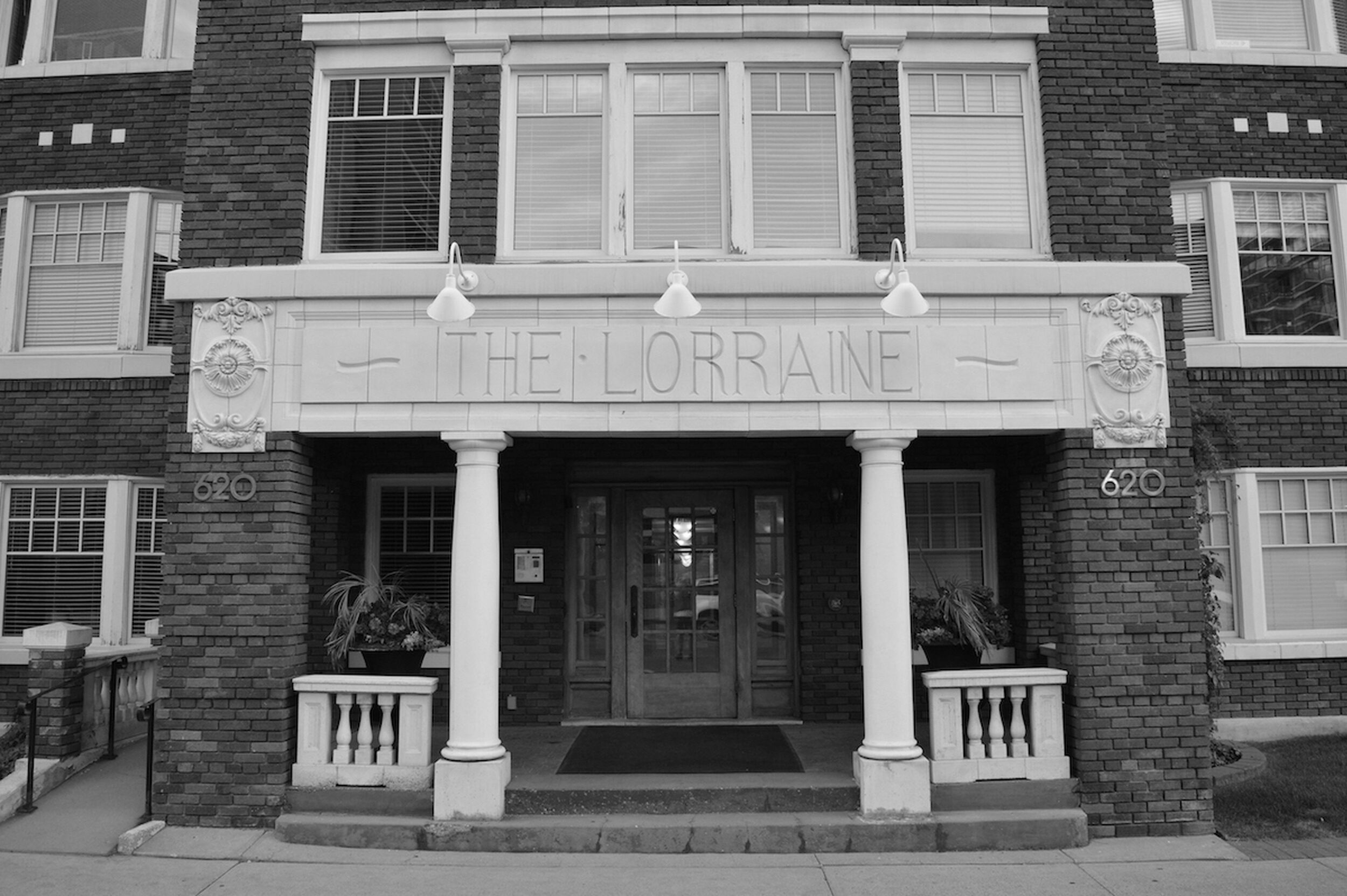
Iconic Calgary building, The Lorraine. Photo: Dave Robinson
Been caught stealing: Life inside The Lorraine
Can we be transformed by a building?
Support in-depth Calgary journalism.
Sign Me Up!We connect Calgarians with their city through in-depth, curiosity-driven journalism—but can't do this alone! We rely on our readers and listeners to fund our work. Join us by becoming a Sprawl member today!
Can we be transformed by a building?
During these times of lockdown and isolation, we are spending more time than ever at home.
Does this change us? What influence does our dwelling have on the people we become? Does the place where we reside leave a lasting impression?
I’ve lived in 12 different homes in my life, including a tall ship. Each residence impacted me in some way. I moved on with a slight variation that I didn’t have before.
Some addresses were more permanent. Others never felt right from the start, so obviously temporary it almost seemed pointless to unpack.
Although it has been over two decades since I lived there, one building has remained a permanent fixture within me.
The Lorraine was my home for almost four years. During my stay, I resided in three different apartments, each a brick and mortar cocoon providing transformation.
Number 3, where I returned home from a whirlwind road trip to Lollapalooza 1994, was a studio apartment furnished with only a futon and a park bench.
I changed out of filthy festival clothes just in time to tend bar at The Warehouse, a few blocks away. Preferring to keep vampire hours, I was a fishnet-stockinged misfit whose lifeline was a nightclub known by outsiders as “The Scarehouse.”
Then I moved on to No. 27, home of difficult life lessons and hard knocks. A place from which I learned death didn’t arrive with the artful poetic grunge of Kurt Cobain’s suicide.
Where I found myself processing the inevitable results of a decade when X wasn’t just the name of my generation and HIV meant you only had a few songs left in the mosh pit.
At last, No. 46, my birthplace as a student of art and the beginning of the rest of my life.
Built in 1912, the four-storey red brick walk-up was, to me, an admission into the life I intended to lead.
The living room window from which my black cat (named Phoenix after River’s untimely Halloween overdose outside The Viper Room) fell four stories to the parking lot below while I watched Friends.
After donations from family and fellow Lorraine tenants, I coughed up my beer money to have the cat’s mangled leg amputated. Her new tripod body a mascot for my own dismembered spirit.
This last apartment was the starting point of a transformation. If I believed in destiny, I would say I was destined to live in No. 46, so that I could now be here.
Built in 1912, the four-storey red brick walk-up emblazoned with “The Lorraine” was, to me, an admission into the life I intended to lead.
As a little girl growing up in conservative Calgary, its three-level portico left me dreamy with visions of life as an artist, a writer, a dancer dangling one leg in front of the terracotta frieze on Twelfth Avenue.
I imagined who might sit up there and what kind of life they could lead. It was the type of life I desired, replete with art and freedom.
Original brick buildings in Calgary are rare. Brick is foreign to us on the prairies, a luxury. It’s that dress kept in the dry-cleaning plastic, for special occasions. I understood this early on.
The Lorraine in the early 1990s was an urban castle, an edifice of liberal ideology and artistic expression.
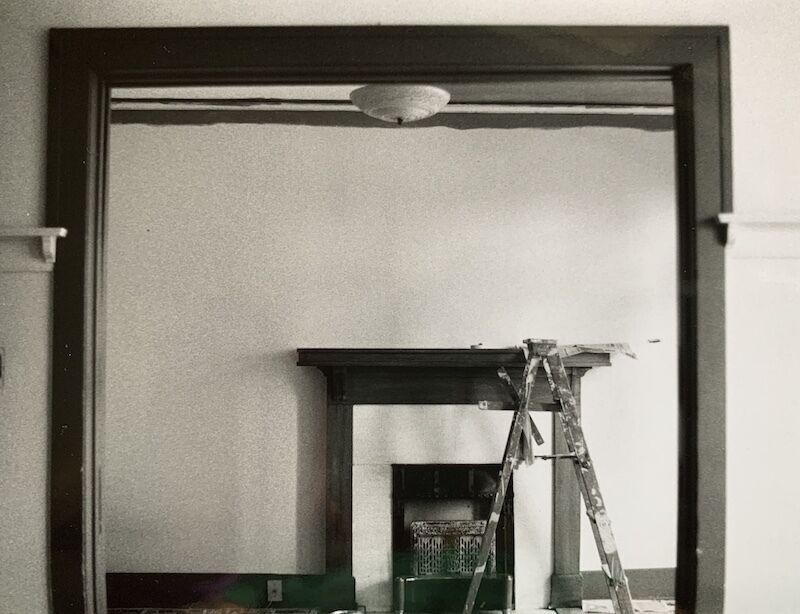
The rumors swirled about how to gain access to the coveted apartments with their hardwood floors and original wainscoting. It was said there was a waiting list, a secret society, you had to know someone, sleep with someone, be in art school, work at a certain bar or café.
The larger two-bedroom apartments were things of legend; only eight in existence, their tenants determined to dwell until the grave.
The truly unattainable, the rare gems of the building were the two bachelor suites on the fourth floor. The only apartments in the building with private brick balconies.
One faced west, nudging itself into the bland office building next door. The other looked east, unobstructed, embracing every sunrise. This was No. 46: the unicorn.
By the time I moved into No. 46, I had entered The Lorraine a thousand times, past the brass mailboxes in the vestibule, across the black and white checkered battleship tiles and up the central staircase.
The halls were filled with scents, but not the usual food smells of a regular apartment building. Aromas like incense, pot smoke, paint thinner and fermenting beer bottles clung to the worn carpet in the upper hallways.
There was a period of a few months that introduced the gradually increasing pungency of someone’s long dead cat in an unreachable nook of the basement (also known as the official rehearsal headquarters for local freak show, Virtual Insanity), but that’s a story for another time.
I worshipped every detail. The crystal doorknobs and vintage stove, the art deco fireplace and out-of-use laundry chute were my treasured fossils.
I was elated when No. 46 became my home. I painted the walls in colours with names like Spring Rock and Raspberry Jam. I hung rattan blinds and sheer white curtains that billowed when the breeze pushed in through the antique balcony door.
I worshipped every detail. The crystal doorknobs and vintage stove, the art deco fireplace and out-of-use laundry chute were my treasured fossils. This was character I appreciated, just as qualities of strength and resilience in a person.
These items bore the proof of longevity, style and history so rare in a city the equivalent of a toddler in terms of metropolitan development. These artifacts had stories to tell.
Apartment No. 46 was one of the lucky few that still had evidence of the original glamour of a Beltline apartment building designed for wealthy businessmen.
Over decades of tenancies—including a stint as a seniors’ assisted-living residence—virtually every light fixture, water faucet and cupboard handle had been replaced by cheaper, lackluster practicality.
No. 46 contained an original art deco frosted glass cover on the light fixture in the living room.
To the unappreciative eye, it was something unnoticed in Grandma’s dated bungalow. To me, it was the epitome of everything I cherished about this grand building. A reminder of The Lorraine’s own youthful adventures.
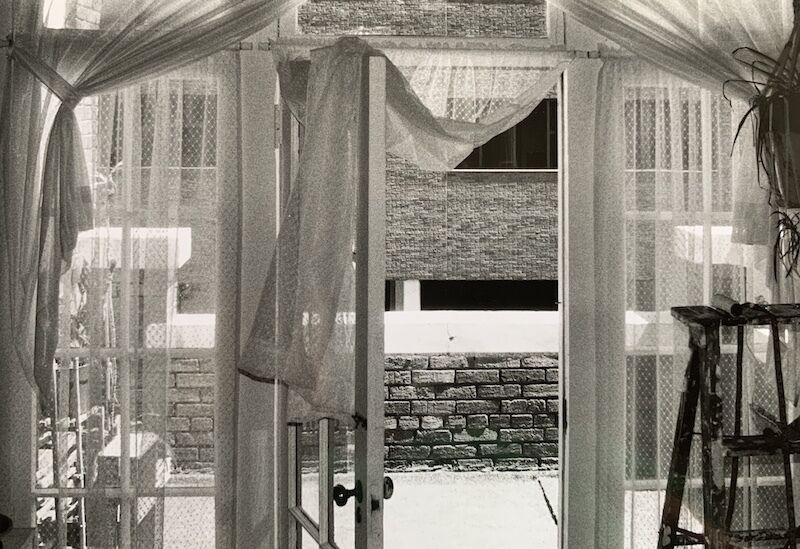
Part of the charm of these apartments was that more recent tenants had been given the freedom to redecorate independently, and some of the slummier landlords relieved to avoid the costs of upkeep.
This practice resulted in a bohemian, eclectic atmosphere.
It also created changes that weren’t optimal to the historic integrity of the building. Circassian walnut paneling painted in garish turquoise, matte black, gloss red. Clawfoot tubs replaced with American Standards.
The existence of this light cover in my apartment was like finding a china doll at a daycare centre. Opaque white and frosted pale pink, it glowed with nostalgia.
At times, the combination of creative people, recreational drugs and young adulthood in the building became too much. The Lorraine could feel like one long morning-after, the constant detritus of last night’s party.
The back staircase became the Canadian version of a front stoop. An indoor observatory of human behaviour.
On the other side of the brick wall, the next-door neighbours from Electric Avenue were weekend binge-drinkers and drug dealers; women hiking up their spandex skirts to pee beside a parked car. By day, the bottle pickers surfed the alleys beside twenty-somethings on a walk of shame or an early-morning taxi ride back to Midnapore, Thorncliffe or Braeside.
The back staircase became the Canadian version of a front stoop. An indoor observatory of human behaviour.
The constant swirl of chaos around the building was surreal. The Calgary Police Service HAWCS helicopter flew overhead on a regular basis.
On one sweltering night, my balcony door open, I emerged to the unmistakable sound of rotors flapping. I looked up from the balcony into the spotlight from the chopper, blasting down on me like something from a UFO movie. I wanted it to beam me up.
The dramatic runoff from the collective wild spirit of The Lorraine had become overwhelming. I was drowning. I had never imagined I would want to leave her, but Lorraine and I had developed a toxic relationship.
I met my husband while attending art school and living in No. 46.
One summer evening during our courtship, at my easel under the frosted light, he called to say he wouldn’t be coming over. He was staying with his parents, in the suburbs.
Dismayed, I wandered onto my balcony, pulling the phone cord with me, the pounding bass from the Fox and Firkin Nightclub pulsing across the alley. “Look at your car,” he said.
I peered over the brick ledge to the parking lot below. There he was, leaning against the passenger door—with an early specimen of a cellular phone pressed to his cheek.
In that moment, it occurred to me that we had manifested the balcony scene from Romeo and Juliet, albeit one involving a 1986 Ford Taurus and muffled techno music.
From there, we evolved into our own permanent fixture. I was ready to leave The Lorraine.
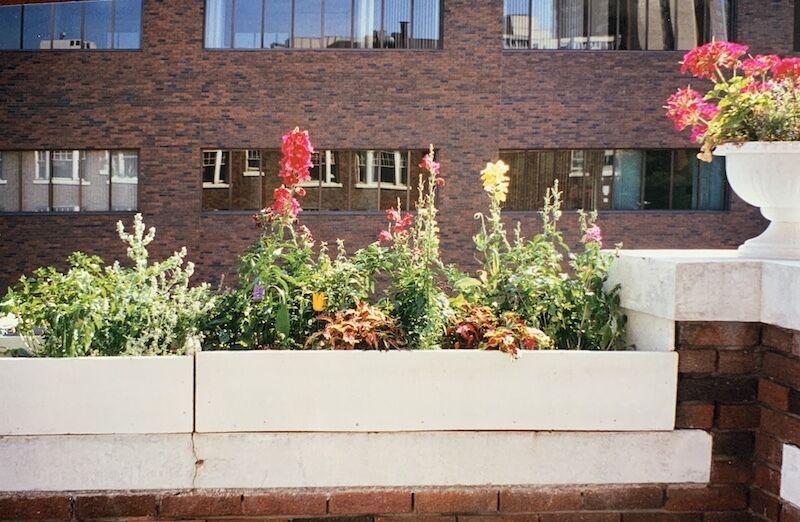
As we packed up the last of my belongings to start our life together, I made the choice to remove the frosted light cover and take it with me. Leaving without it felt like putting something vulnerable and delicate at risk.
Granted, I selfishly wanted my own piece of the building, something to remember her by, but it wasn’t a simple trophy. I felt the miracle of its survival into 1997 was pure chance. I didn’t want to risk the decorative choices of the next tenant. Like an apathetic landlord, I replaced the cover with something generic from Home Depot and closed the door on No. 46.
Two months later, a tenant on the second floor parked a scooter full of gasoline in her apartment and fell asleep with a lit cigarette in the ashtray.
She had inherited two cats from another tenant who died tragically a couple of years prior. Legend has it, the cats knocked the ashtray from the arm of the sofa, starting the fire that spread quickly after it reached the scooter’s gas tank.
The Lorraine burned until morning. All 32 apartments were evacuated safely.
The manager had gone up and down the hallways, banging on doors to wake everyone. The men who had moved into my unicorn, No. 46, were rescued from the balcony as the tarred roof collapsed in flames.
They had pushed the flower boxes—built by my dad—off the balcony wall. Leaning over the edge they attempted to breathe fresh air under the billowing smoke.
The Lorraine burned until morning. All 32 apartments were evacuated safely.
I remembered how heavy I slept, during my time at The Lorraine, sedated by my own endless party. I knew the banging on the door wouldn’t have roused me.
Had those men been asleep? Did they like Spring Rock and Raspberry Jam or had they painted over my walls?
I imagined myself a casualty under the smoldering colours, unconscious beneath the layers peeling in the heat, the roof having burned away, revealing the stars.
That winter, in the early months of 1998, I was keenly aware of having got away with more than just the frosted light cover when I moved out of The Lorraine.
The arsonist cats were lost and, of course, The Lorraine herself.
The third and fourth floors were destroyed by fire. Water damage ruined the first two storeys. All of the tenants were left homeless. The brick façade and structure withstood the blaze, but the eclectic splendor was gutted.
The Lorraine, that I knew so intimately, was gone.
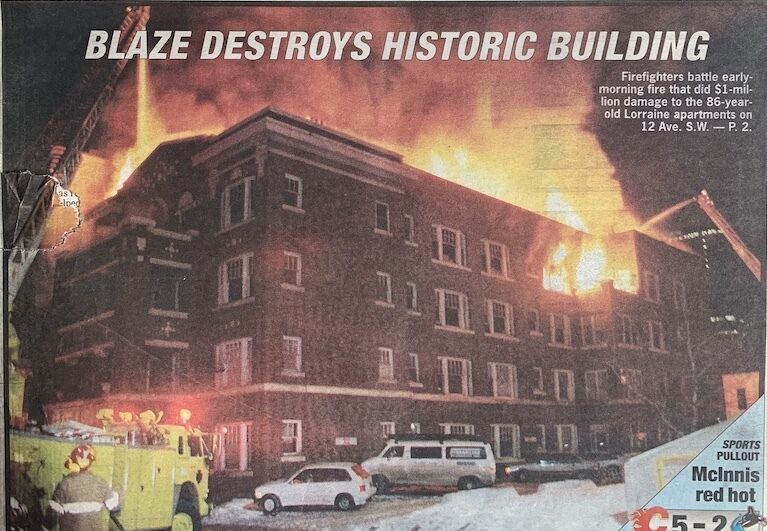
She was declared a heritage building and restored to a modernized version of her former self. From the outside, she’s the same grand beauty today with the portico and the terracotta frieze. The inside houses local businesses and boasts rustic exposed brick walls.
I am grateful to the owners for loving the building enough to maintain her beautiful bones, but The Lorraine is no longer anyone’s home. For that, it will always seem a little empty.
In the years after No. 46, we left the frosted glass cover with my parents for safekeeping. They installed it in their hallway, where it remained until I woke up one day, urgently needing it back.
I had been dreaming that I was, once again, living in The Lorraine with my husband and children. This time in a larger, more family-friendly version of No. 46. I still have this dream, now and again.
Perhaps, having that frosted pale pink glow in my home is a way for me to be back there in the building that seduced me with the promise of a story.
I turn on the light in my brick bungalow and I am taken to the plaster hallways, yellow with smoke and tears and experience; the laundry chutes echoing laughter and nervous anticipation.
It illuminates a part of my life when Romeo called up to my balcony and we couldn’t help but take a piece of that moment with us, for fear of it being lost on someone blind to its importance.
The glow reminds me that I was once a girl who left the balcony door open to watch the billowing curtains and fall asleep under the many layers of paint on those walls.
I woke from a fever dream to become a mother, driving past The Lorraine, taking my kids to school.
Each apartment was an old jewelry box with the little dancer inside.
What happened in that building or adjacent to it, under it and on top of it was impossible. Stories so numerous and outrageous they seem impossible.
They were bliss and ecstasy and horror and the most profound sadness I have ever felt. They were the life I knew I didn’t want to miss when I drove by as a little girl, in a station wagon with my mom, before I knew the true cost of living.
Each apartment was an old jewelry box with the little dancer inside. When you opened a door, some of the figures twirled joyfully to twinkling melodies. Others were broken, their rotations stalled, the song stuck on a mournful note.
The brooding bartender from the Republik Nightclub with a cat named Blanche; the bearded man who dressed up as the bee girl from the Blind Melon video and died of AIDS in the apartment below mine; the loveable, mysterious nightclub manager from No. 31 who died in a jarring, violent instant, leaving his cats to start the fire... These people were real.
The Lorraine heard them yell and cry and laugh. She watched as they tripped on the stairs or climbed them two at a time. For a while, their stories happened in those four storeys.
When I flip the switch, the frosted pink light glows with the fickle energy of The Lorraine. It illuminates everything I lost and gained within those brick walls.
I realized the light fixture is a trophy, an acknowledgement of the stories that became today. When I look around me, it feels like I’ve been caught stealing.
Heidi Klaassen is a born and raised Calgary writer of fiction and non-fiction. She works for the Alexandra Writers’ Centre Society and her eco-friendly label, Hekkal & Hyde. She lives in Calgary with her husband, sons and rescue chihuahuas.
Support in-depth Calgary journalism.
Sign Me Up!We connect Calgarians with their city through in-depth, curiosity-driven journalism—but can't do this alone! We rely on our readers and listeners to fund our work. Join us by becoming a Sprawl member today!
